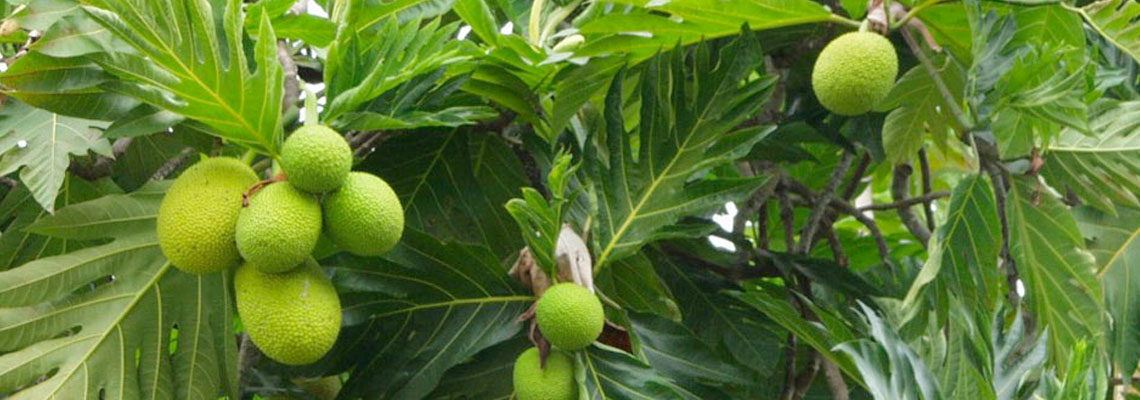Ulutopia is a research field at Kauai Community College for Breadfruit (Artocarpus altilis (Parkinson) Fosberg; Moraceae) husbandry where most of the field activities such as planting, irrigating and data recording are implemented with the participation of undergraduate students.
Ulutopia is also a place for sharing breadfruit related agronomical information to community adults and scholars.
What is Breadfruit?
 Breadfruit, Artocarpus altilis (Parkinson) Fosberg; Moraceae), is a staple crop in Hawaii and throughout Oceania. This crop is grown for its starchy fruit (Ragone, 1997). Breadfruit’s potentially to alleviate hunger in the tropics has been under utilized and neglected.
Breadfruit, Artocarpus altilis (Parkinson) Fosberg; Moraceae), is a staple crop in Hawaii and throughout Oceania. This crop is grown for its starchy fruit (Ragone, 1997). Breadfruit’s potentially to alleviate hunger in the tropics has been under utilized and neglected.
Objective of Ulutopia
The broad objective of Ulutopia is to develop undergraduate students’ research skills. The specific objective of this research is to find out the effects of fertilizer and sunn hemp cover crop on soil micro organisms, plant growth and crop yield.
- Habitat, Characteristics and Economic Values
- Health Benefits, Multipurpose and Methods of Preparation
Habitat Ulu grows best in hot, moist places throughout Tropical Asia and Polynesia, especially abundant in the Marquesas. Fertile loam soil with good drainage is best for `ulu.
Characteristics
Leaves: The breadfruit is considered to be the most beautiful tree with symmetrical shape and wonderfully large leathery leaves. The leaves may be as long as 1-3 feet, cut into several blunt lobes.
Flowers: Male and female flowers are borne on separate trees. male flowers are stiff, club shaped spike 6-12 inches long, while the female flowers are round or oblong green head.
Fruit: The fruits are brownish when ripe, about 10 pounds, with tough, warty skin. Pulp is sweet and mealy and fibrous. New plants can grow from cuttings or from root sprouts.
Economic Values: The fruit serves as a carbohydrate food source and the wood has many uses as well. Although it is not a staple food in Hawaii it is the staple food in Marquesas and is eaten throughout Polynesia.
The `ulu (breadfruit) held a special place in the hearts of the Hawaiians. This is best explained by the myth of its origin which claims that during a time of famine Ku, the god of building and war, turned into an `ulu tree so his wife and children would not starve. Being that it is a kinolau (body form) of Ku it is kapu (forbidden) to women. Thus `ulu served mainly as a famine food in Hawai'i.
The `ulu tree served many important functions aside from a source of food. The Hawaiians used the wood for canoes (ocean vessels), the trunks were hollowed out to make drums and short surfboards, and the sap was used for caulking and to catch birds. The fibers were sometimes used to make an inferior kapa (bark cloth) and the male inflorescence provided a dye that ranged in color from yellow to tan to brown, depending on its maturity. The breadfruit design is popular for the Hawaiian quilts.
In Samoa the fruit is preserved by burying when the crop is great. In Marquesas each child at birth, is given a tree, because they believe that 1 or 2trees will support a person for life. In 1792 Bligh's expedition brought1200 `ulu trees from Tahiti to Jamaica, where it spread to the Caribbean. In Tahiti, the `ulu was a gift of a loving father to his family during famine times. The father grew as an `ulu tree that fed his hungry family.
Health Benefits: Breadfruit is high in carbohydrates and a good source of antioxidants, calcium, carotenoids, copper, dietary fiber, energy, iron, magnesium, niacin, omega 3, omega 6, Phosphorus, potassium, protein, thiamine, vitamin A and vitamin C.
Multipurpose: Not only a substantial food source, the breadfruit tree also provides a multitude of other advantageous uses.
Gluten-Free Flour: Breadfruit can be processed into a gluten-free flour, far superior in taste, nutrition and structure to any other GF flour alternative.
Insect Repellant: In addition to being a safer alternative to DEET, the male breadfruit flower is highly effective at repelling mosquitoes and other insects.
Latex: The sap excreted from the breadfruit can be used as a waterproof caulking for watercrafts and homes, as well as chewing gum.
Fabric: Fibers from the bark of the breadfruit tree can be harvested without killing the crop and used to make mosquito nets, clothing, accessories, artwork and even paper.
Animal Feed: Fallen fruits, as well as the leaves of the tree, can be used as nutritious animal feed.
Methods of Preparation: Breadfruit is gluten-free and can be consumed at all stages of development; ripe as a fruit or mature as a vegetable—where it can replace conventional starches. (Think of it as a tropical potato.) As the fruit ripens, the starches convert to sugars and the flesh softens to a custard-like consistency. Aside from being eaten raw, breadfruit can be baked, boiled, candied, fried, pickled, roasted and steamed. The fruit can be shredded, dried for storage or easily processed into gluten-free flour.
Contact us
Brian Yamamoto
Faculty Lead
Email: btyamamo@hawaii.edu
Phone: 808.245.0241

